All about toothpicks

The tooth stick is one of the main tools for oral care. Not only the cleaning efficiency, but also the health of teeth and gums will depend on its quality and shape. Therefore, before choosing a product for individual use, it is very important to learn everything about toothpicks, their types and materials of manufacture.


History
A toothpick or tooth stick (translated from English - toothpick) is a special small elongated object designed to remove food debris stuck in the oral cavity, mainly between the teeth and gums. They help to effectively and painlessly, without damaging the tooth enamel and gingival mucosa, remove pieces of meat, fish, peel of vegetables or fruits and other particles of hard food. Today these devices are very popular, they can be found in every cafe or restaurant, at home or in the office canteen. But tooth sticks were invented and used in ancient times, and, according to scientists, they were invented in the prehistoric period - more than a million years ago.
During the study of the remains of an ancient man who lived in those distant times, researchers found particles of wood origin stuck between his teeth. Based on this, scientists have made the undeniable conclusion that paleoanthropes, like modern people, sought to cleanse their mouths of food debris. To do this, they used tree twigs, elastic blades of grass and other available plant materials.
That is, already at that time, the Neanderthals understood that food stuck between the teeth gradually leads to deterioration and loss of teeth, as well as the development of various diseases of the gums.


The inhabitants of Ancient Rome used a wider range of different devices for these purposes, as evidenced by the records of historians of that time. Representatives of the nobility and wealthy estates always carried a stick made of soft wood or a thin bone. These products became especially popular during the Renaissance - among the nobles of European states it was customary to carry their personal toothpick with them, which they cling to a chain and hung around their necks along with jewelry. The hygiene items of these privileged persons were also unusual - they were made of soft precious metals (gold and silver).
Ordinary people continued to use chopsticks of natural origin. For example, in the countries of South America, in particular in the territory of modern Mexico, toothpicks were made from the long thorns of a wild cactus. The Indians turned out to be more inventive in this regard - they used products from bird beaks, fish bones and even walrus mustaches to brush their teeth, not to mention ordinary wooden sticks. Moreover, they also tried to have their own personal toothpick, which they always carried with them.
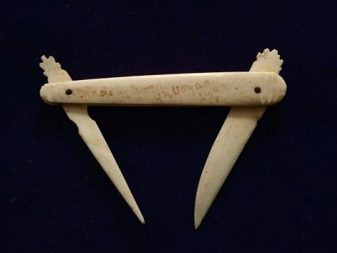
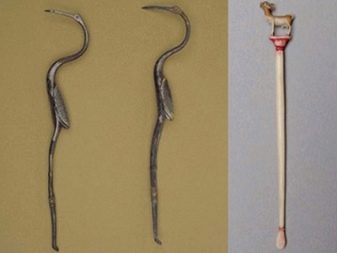
Later, starting in the 18th century, reusable bird feather toothpicks became widespread. Chicken and goose feathers were best suited for this; such products at that time could be made by yourself or purchased from street vendors. Old, out-of-service writing pens were often used.
At the end of the 19th century, reusable teeth brushing sticks made of vulcanized rubber began to appear, and a little later – from celluloid. Today, people also use various materials at hand for these purposes, but factory-made toothpicks are made exclusively from special materials approved by doctors. After all, some modern products help not only clean the teeth of food debris, but also freshen the breath, for example, sticks with a green tip - mint or menthol.
Special medical toothpicks, among other things, also contribute to the prevention and treatment of many diseases of the oral cavity.


Views
Modern toothpicks are classified according to several indicators: size, materials of manufacture, additional properties, but the most important criterion is the frequency of use. Today, manufacturers supply the market with both single-use toothpick sets and individually packaged reusable products.
Reusable
The most common types of reusable toothpicks are plastic and metal, less often silicone products go on sale. Most reusable models have special antimicrobial coating... If it is absent, then at least toothpicks suggest treatment with disinfectant solutions or boilingeg metal options.
All reusable toothpicks are usually sold complete with a special container where the device is placed after use - so it is convenient to carry it in your pocket or bag without risking getting dirty. In addition, the container protects the product from germs.
However, do not forget that after brushing your teeth, you cannot reuse the stick without disinfecting it, since rotting food debris in itself contributes to the formation and spread of harmful bacteria already inside the protective container.
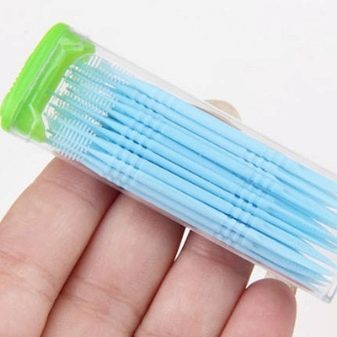

Disposable
Disposable toothpicks are the most common type of product. They are usually made of wood or bamboo, but plastic or rubber versions are also available commercially. Single-use devices are considered more hygienic, since even the most effective disinfection does not guarantee the complete destruction of harmful microbes.
There are several options for packaging such toothpicks - packages of 50, 100, 200 or more pieces, as well as a separate plastic or paper package with one toothpick. Packing with a large number of products is more intended for home use, and individually packaged toothpicks are often used in catering establishments (cafes, restaurants, canteens), which provides additional protection against bacteria and compliance with hygiene standards.
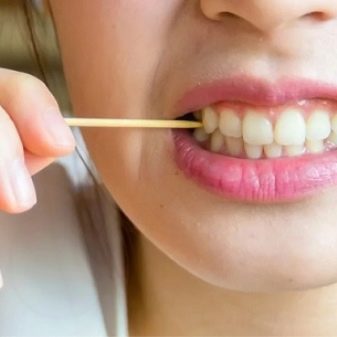

What are they made of?
Unlike the Middle Ages, when improvised tools were often used to brush teeth, modern toothpicks are made according to approved state standards. At least all official manufacturers must adhere to the GOST rules; the difference can only be low-quality products, usually made in China from dubious companies. There are four main types of material for making toothpicks.
Wooden
Wooden toothpicks occupy the first place in popularity; they are a thin stick of a certain length, pointed at one or both ends. Often on sale you can find flavored wooden devices, on the tip of which a special composition with the taste of mint or menthol is applied. According to reviews, such toothpicks are quite effective in helping to freshen the breath after spicy food, fish, onions or garlic, as well as with partial tooth decay.
Absolutely all wooden products are disposable, since the pores of the wood are a favorable place for the formation and reproduction of harmful microorganismsthat can get there with food debris. Despite the fact that wooden toothpicks are relatively soft and harmless to tooth enamel, they must be used very carefully, otherwise the sharp tip can damage the delicate surface of the gums.
It is better to choose bamboo and beech products, because they are less prone to delamination and splitting during the cleaning process. Cheap options from other tree species often break, their particles get stuck between the teeth, causing pain.


Plastic
Plastic or plastic sticks are more hygienic, many of them are reusable - after rinsing and disinfection, they can be reused. Today, there are not only rounded, but also plastic toothpicks with a triangular section on sale. - it is believed that they are more convenient to use, more effectively remove dirt stuck between the teeth, since the triangular shape fits better into the interdental spaces. There are also models with a thin layer of silver applied to the sharp tip - this not only provides mechanical cleaning, but also kills bacteria in the oral cavity. Plastic devices come in a variety of colors: white, green, gray, and even black.


Titanium
Titanium toothpicks are the strongest and most durable, but they require very careful use, since the hard material can easily damage not only the gums, but also the tooth enamel. Convenient in washing and disinfection, so all models are reusable. Titanium sticks have a presentable look and are especially popular with luxury lovers. The most common models are made in the form of a fountain pen with a cap, under which a special curved needle is hidden - it helps to more effectively clean the interdental spaces in hard-to-reach places.
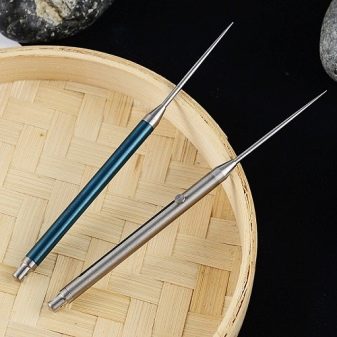

Medical
Medical toothpicks are considered the best option, and if earlier it was rather difficult to find them on sale (they were sold only in specialized stores), today the products are presented in almost every pharmacy. Most of the models are made of special stainless steel, which is sterilizable and reusable. The material is absolutely safe, does not harm the tooth enamel and does not irritate the gingival mucosa.
Almost all types of medical metal toothpicks have a special coating on their surface for the prevention and treatment of a number of diseases. For example, flexible toothpicks are made with the tip applied to them:
- sodium fluoride;
- xylitol.
They prevent the formation of plaque and prevent the destruction of enamel, and thanks to a minimum diameter of 0.1 millimeter, they are able to penetrate into the narrowest gaps between teeth.


Recently, special plastic medical devices with dental floss have become popular. This toothpick is made not in the form of a stick, but as a kind of handle, one end of which is pointed, and the other forks, and dental floss is attached to it. According to consumer reviews, such a product helps to effectively clean teeth from different angles. Manufacturers additionally impregnate the thread itself with special oils and medicinal compositions with different tastes:
- orange;
- mint;
- lime;
- lemon.
This model was invented in Russia in 1999, the Doctor Steve factory launched the production of a unique device for cleaning teeth with Flosstik floss. Today they have become one of the most popular and occupy the first place in the Russian Federation in terms of sales among similar products, second only to ordinary wooden disposable options. It should be noted that a stick with a thread is a patented product, the patent for it belongs to the only production factory in the Russian Federation, Dr. Steve.
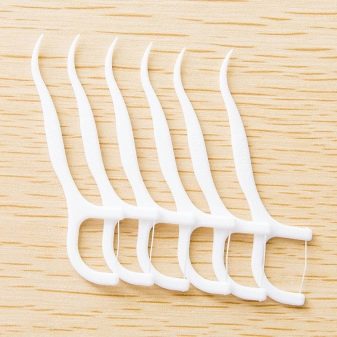

Dimensions (edit)
The length of standard wooden disposable toothpicks is approximately 6-7 cm, and their diameter ranges from 2 to 2.5 mm. The weight of such a device, of course, is very small, it does not even reach one gram, but depends mainly on the thickness and specific material of manufacture - the type of wood used. For example, a budget flat stick of Chinese production weighs about 0.137 g - it is a relatively thick and therefore not very convenient product; during cleaning, the tip quickly disintegrates into individual fibers.
The more expensive version from European manufacturers weighs 0.12 g - a thin material with well-pointed durable tips that do not frizzy, hold their shape well. On average, according to research by independent experts, the weight of one toothpick ranges from 0.11 to 0.14 g.



What is it used for?
You can use toothpicks not only for their intended purpose. Today, the products find many other uses, for example, in household or cooking:
- for cleaning a computer keyboard - by wrapping cotton wool around a wooden stick, you can easily remove dirt between buttons and keys;


- for painting on coffee crema - the thin tip of a toothpick allows you to create a variety of detailed patterns without destroying the delicate surface of the drink;


- as skewers for canapes - dishes decorated with multi-colored toothpicks look very original;


- to check the readiness of baked goods or meat - by piercing the product with the sharp end of a toothpick, you can quickly determine the degree of its readiness, and the wooden product will not leave traces or spoil the taste.


Manufacturers
Aviora
The company produces sticks with a smooth surface and sharpening at both ends, the tops of which are slightly rounded to prevent injury. Suitable for people with sensitive and bleeding gums.

Home queen
Birch wooden toothpicks. They have a convenient package with a universal rotary lid that allows you to take out one stick at a time without affecting the rest.

Market flesh
Toothpicks are packaged in individual cardboard packaging, where each product is placed in a separate plastic bag. Sharp tips have a special menthol coating.

Fackelmann
This German brand is considered one of the best among the world manufacturers of toothpicks. Products have different packaging, are made of materials of increased strength.

Selection rules
When choosing toothpicks, first of all, you should pay attention to manufacturer... Low-cost Chinese products, as a rule, are of very low quality and are made from questionable materials that can simply break when used and injure the oral cavity. You need to take into account and conditions of use - packaging with a large number of products is suitable for home, it will be convenient and economical; for travel or dinner at a party, you should choose toothpicks, individually sealed in separate mica.
Only titanium products are suitable for permanent use, since plastic ones, although considered reusable, lose their shape after 5-6 times of use and no longer remove dirt so effectively.




